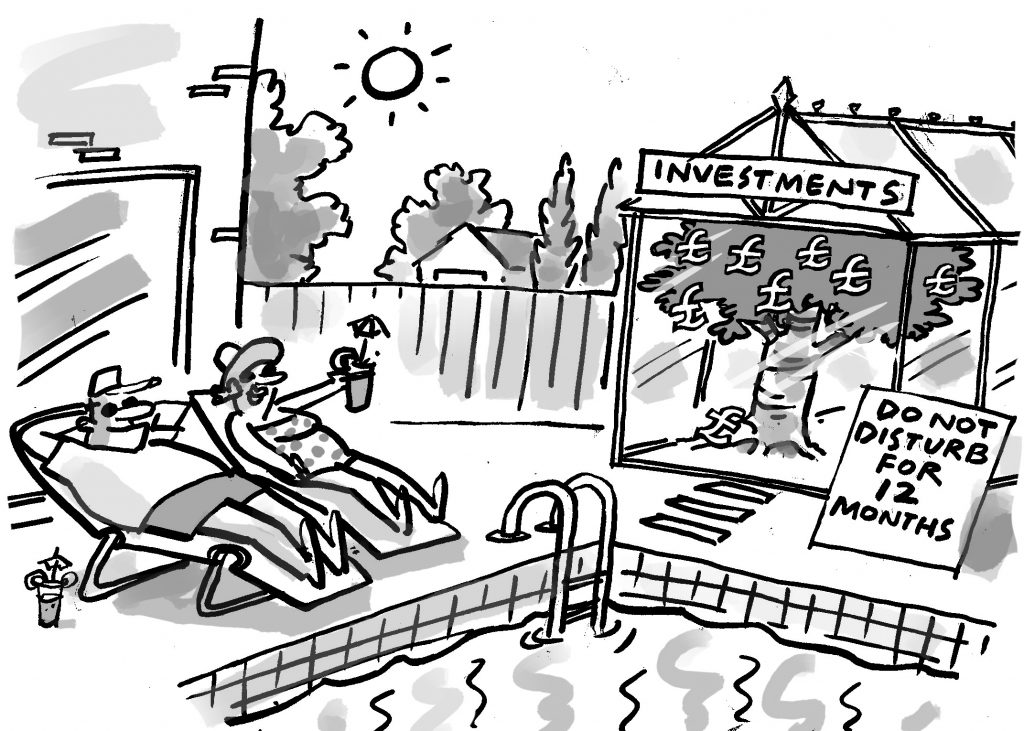After Investing
The whole point of investing is to have something to look forward to. It should not be something you dread and fear.
My process for investing not only prevents me from being ripped off, it also helps me to largely forget about my investments and get on with my life.
Scroll down the page to see how straight-forward this can (and should) be.

The actions required after investing largely boil down to two things:
- “Rebalancing” – Making sure the allocations stay as similar as possible to the model portfolio that I’m copying, and
- Adding more money in a cost-efficient way.
On this page:
Rebalancing
– How often do I rebalance?
– Change in personal circumstances
– When I might start to rebalance
– Ignore the value, focus on the allocations
– Example of rebalancing
– The numbers – Step-by-step examples
Adding more money in a cost-efficient way
Rebalancing
Rebalancing is adjusting the allocations within my portfolio to make sure that they are still in line with my model portfolios.
I want to match the appropriate model portfolio because it represents what I found to be the average allocation made by massive banks and investment firms who’ve put loads of research and analysis into this.
Return to the top of the screen
How often do I rebalance?
This is something I do annually. Some people with large investment portfolios (more than £50,000) might prefer to do this more often but I think that just incurs fees and is too much of a hassle.
Generally speaking, I would rebalance once a year if my portfolio has deviated by 5% or more from the Model Portfolio that I’m following. For example, if the Model Portfolio allocates 1% in cash, 45% in mixed bonds and 54% in global shares but my portfolio has move to 2% in cash, 41% in mixed bonds and 57% in global shares, then I’d be inclined to sell 3% of the global shares and buy 4%-worth of mixed bonds.
If the deviation from the Model Portfolio is really small, I might just add money to one asset class to bring my portfolio back in line with the Model Portfolio.
For example, if the most appropriate Model Portfolio for me was the Medium-Risk Tier 2 Model Portfolio, it would have target allocations of 1% in cash, 45% in mixed bonds and 54% in global shares. But if my actual portfolio worked out at, say, 1% in cash, 44% mixed bonds and 55% global shares, then I could just keep adding to the mixed bonds pot until it more or less reached 45% of the overall investment portfolio.
Return to the top of the screen
Change in personal circumstances
If something happened to me that made my appetite for risk change, then I would almost certainly change my investment allocations to reflect my new situation.
 Rip-off Tip-off – Retake the Risk Assessment Every Few Years
Rip-off Tip-off – Retake the Risk Assessment Every Few YearsIt’s a good idea to retake the risk assessment questionnaire every three to four years. Things change and your answers might indicate a different appetite for risk (lower or higher).
For example, if I realised that I had become more (or less) comfortable with risk, then I would retake the risk assessment questionnaire. If these more recent results indicated that my appetite for risk had changed, I would reallocate my investments to match the model portfolio that most closely reflected my new appetite for risk. The process would be the same as that used when rebalancing my portfolio.
Return to the top of the screen
When I might start to rebalance
Let’s suppose that I set up a Tier 2, Medium-Risk portfolio one year ago with £10,000. When I set it up, I allocated the money to match the Tier 2, Medium-Risk Model Portfolio’s allocations.
I then spend a year not thinking about my investments but, rather, getting on with my life and letting the investments take care of themselves. Very sensible.
After a year, it’s time to take a look at my investments and see if I need to make any adjustments.
Return to the top of the screen
Ignore the value, focus on the allocations
I’m not concerned with whether the overall portfolio is has grown or fallen in value. I know that, having set up the investments properly in the first place, their best chance of growing is if I leave them alone and don’t interfere with them. Interfering with them costs me money and is likely to leave me worried about the short-term price movements of bonds and shares.
I am concerned with making sure that the allocations to the different asset classes continue to copy the model portfolio that is right for me. I will update those model portfolios from time to time. However, for the purpose of explaining rebalancing here, let’s assume that the model portfolio hasn’t changed.
Return to the top of the screen
Example of rebalancing
The charts and table below show the model portfolio’s allocations on the left and what my portfolio’s allocations are after a year of being left alone to do their thing.
| Cash | Global Government Bonds | Global Corporate Bonds | Global Shares | Alternatives | |
| Model portfolio | 1% | 21% | 22% | 51% | 5% |
| My portfolio | 1% | 17% | 24% | 54% | 4% |
| My current allocation is… | Balanced | 4% too low | 2% too high | 3% too high | 1% too low |
Actions I need to take
I can see the following:
- Cash has remained at roughly 1%, so I don’t need to do anything about that
- Global government bonds account for 17% of the overall portfolio. They might have fallen in value or grown at a slower speed than other assets; it makes no difference.
What matters is that I need to increase the allocation to global government bonds by four percentage points so that the allocation reaches 21% of my overall portfolio. - Global corporate bonds account for 24% of the overall portfolio. I need to reduce that to 22%.
- Global equity has risen to 54%, so I need to reduce that to 51%.
- Alternatives have dropped to 4%. That needs to be raised to 5%.
The allocations here are still fairly close to the model portfolio’s allocations. I could just leave it alone for another year and only rebalance if something goes more than 5% away from the model allocations. But it’s only once a year and I want to keep my portfolio in line with the Model Portfolio because things can change suddenly and I don’t want things to go too far off course.
Therefore, in this instance, I would move some money from global corporate bonds into global government bonds, and I’d move some money from global equity and into global government bonds as well as into alternatives.
Return to the top of the screen
The numbers – Step-by-step examples
Simple example
Let’s assume that the overall portfolio hasn’t grown in value and remains at exactly £10,000.
1% of £10,000 = £100 (£10,000 x 0.01).
Therefore, in this example, I need to do the following:
- Move 2% i.e., £200, out of global corporate bonds and into global government bonds
- Move 3% i.e., £300, out of global equity and
- put £200 of that into global government bonds
- put the remaining £100 into alternatives.
More realistic example
The numbers are never conveniently round. Let’s take an example in which I have, say, £13,754. 1% of £13,754 = £137.54 (£13,754 x 0.01).
Therefore, in this example, I need to do the following:
- Move 2% i.e., £275.08, out of global corporate bonds and into global government bonds
- Move 3% i.e., £412.62, out of global equity and
- put £275.08 of that into global government bonds
- put the remaining £137.54 into alternatives.
The actual numbers would not be this precise. When you invest in a fund you buy “units” in a fund. The cost of each unit changes all the time and it’s rarely a nice round number.
For example, I might have £137.54 with which to buy units in my preferred alternatives fund but each unit might cost, say, £5.37. That would allow me to buy 25 units of the alternative fund for a total value of £5.37 x 25 = £134.25. That would leave £3.29 unspent and sitting in my cash allocation, which is fine. You’ll see this in practice in the step-by-step examples in Section 9 of this book.
I’d aim to take, say:
- Between £270 and £280 out of global corporate bonds and put it into global government bonds.
- Between £410 and £420 out of global equity and
- put between £270 and £280 of that into global government bonds
- put as much as whatever’s left as I can into alternatives.
Return to the top of the screen
Adding more money in a cost-efficient way
Bearing in mind that I pay between £6 and £9 every time I buy (or sell) something, I wouldn’t buy more funds unless I had at least £500 to invest in one go.
An additional £500 to invest
If I had another £500, I’d probably buy just global shares. Then, when I had another £500, I’d buy £250 of global government bonds and £250 of global corporate bonds.
An additional £1,000 to invest
If I had another, say, £1,000, I’d buy £780-worth of global shares and split the rest between global government bonds and global corporate bonds (i.e., £110 on each). The property allocation is only 5%. That would equate to £50 from my additional £1,000. I’m not going to lose £6 of that £50 on transaction costs. I’d probably wait until my annual rebalancing to adjust the allocation to property.
With smaller sums like this, my priority would be to keep investing, and not worry too much about the exact allocations.
An additional £5,000 or more to invest
Once the amount that I have in additional funds to invest exceeds £5,000, I’d allocate in line with my model portfolio. In the example I’ve shown here with Interactive Investor, that’s 78% to global shares i.e., £3,900; 8% to global government bonds and 8% to global corporate bonds i.e., £400 to each; 5% to property i.e., £250.

